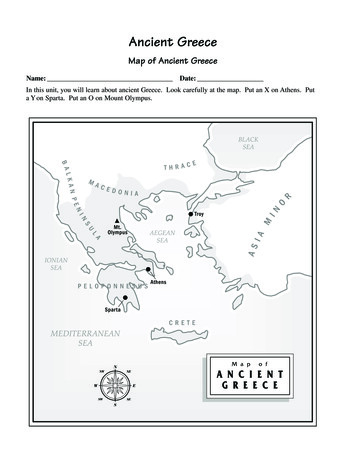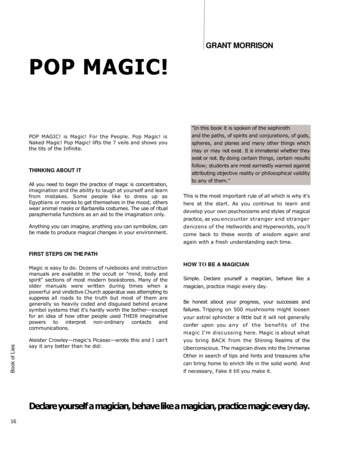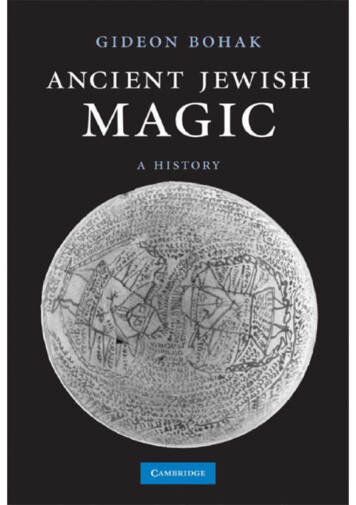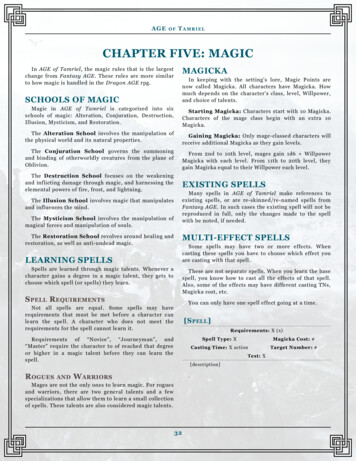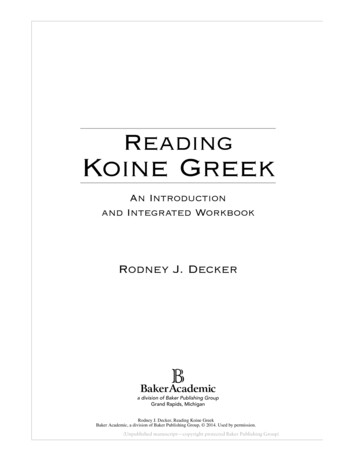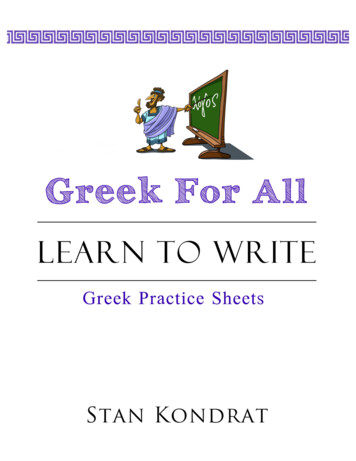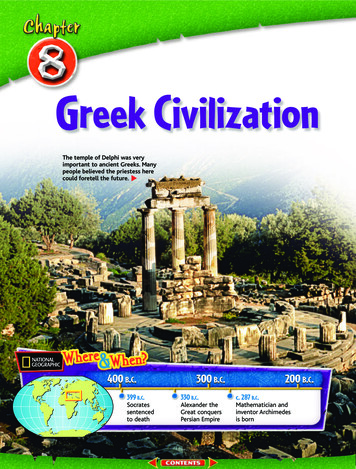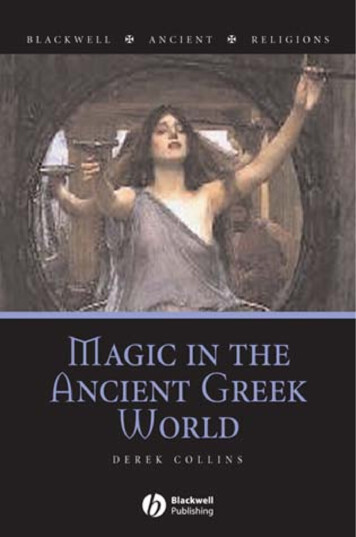
Transcription
9781405132381 1 pre.qxd 30/10/2007 12:09 Page iMagic in the Ancient Greek World
9781405132381 1 pre.qxd 30/10/2007 12:09 Page iiBlackwell Ancient ReligionsAncient religious practice and belief are at once fascinating and alien fortwenty-first-century readers. There was no Bible, no creed, no fixed setof beliefs. Rather, ancient religion was characterized by extraordinarydiversity in belief and ritual.This distance means that modern readers need a guide to ancient religiousexperience. Written by experts, the books in this series provide accessibleintroductions to this central aspect of the ancient world.PublishedMagic in the Ancient Greek WorldDerek CollinsReligion in the Roman EmpireJames B. RivesAncient Greek ReligionJon D. MikalsonForthcomingReligion of the Roman RepublicChristopher McDonough and Lora HollandDeath, Burial and the Afterlife in Ancient EgyptSteven SnapeAncient Greek DivinationSarah Iles Johnston
9781405132381 1 pre.qxd 30/10/2007 12:09 Page iiiMagic in the AncientGreek WorldDerek Collins
9781405132381 1 pre.qxd 30/10/2007 12:09 Page iv 2008 by Derek Collinsblackwell publishing350 Main Street, Malden, MA 02148-5020, USA9600 Garsington Road, Oxford OX4 2DQ, UK550 Swanston Street, Carlton, Victoria 3053, AustraliaThe right of Derek Collins to be identified as the author of this work has beenasserted in accordance with the UK Copyright, Designs, and Patents Act 1988.All rights reserved. No part of this publication may be reproduced, stored in aretrieval system, or transmitted, in any form or by any means, electronic, mechanical,photocopying, recording or otherwise, except as permitted by the UK Copyright,Designs, and Patents Act 1988, without the prior permission of the publisher.Designations used by companies to distinguish their products are often claimed astrademarks. All brand names and product names used in this book are trade names,service marks, trademarks, or registered trademarks of their respective owners. Thepublisher is not associated with any product or vendor mentioned in this book.This publication is designed to provide accurate and authoritative informationin regard to the subject matter covered. It is sold on the understanding that thepublisher is not engaged in rendering professional services. If professional adviceor other expert assistance is required, the services of a competent professionalshould be sought.First published 2008 by Blackwell Publishing Ltd1 2008Library of Congress Cataloging-in-Publication DataCollins, Derek.Magic in the ancient Greek world / Derek Collins.p. cm. — (Blackwell ancient religions)Includes bibliographical references and index.ISBN 978–1– 4051–3238–1 (hardcover: alk. paper)—ISBN 978–1–4051–3239–8(pbk. : alk. paper) 1. Magic, Greek. I. Title.BF1591.C57 2008133.4′30938— dc222007027073A catalogue record for this title is available from the British Library.Set in 9.75/12.5pt Utopiaby Graphicraft Limited, Hong KongPrinted and bound in Singaporeby Markono Print Media Pte LtdThe publisher’s policy is to use permanent paper from mills that operate asustainable forestry policy, and which has been manufactured from pulp processedusing acid-free and elementary chlorine-free practices. Furthermore, the publisherensures that the text paper and cover board used have met acceptable environmentalaccreditation standards.For further information onBlackwell Publishing, visit our website atwww.blackwellpublishing.com
9781405132381 1 pre.qxd 30/10/2007 12:10 Page iiixxi1 Magic: What Is It and How Does It Work?Frazer and TylorMalinowskiMagic as CommunicationLévy-BruhlEvans-PritchardSympathetic MagicMagic and the Extended PersonMagic and AnalogyBeyond FrazerTambiah and Persuasive MagicConclusion13557111416172021242 A Framework for Greek MagicMagic and the GodsDivinity and NatureThe Hippocratics: Magic, Divination, and EpilepsyPlato and Greek PsychologyMagic and CausalityGreek MagiciansMagoiGorgias, Mageia and GoBteiaOther Magical TermsConclusion2727313342444954586062
9781405132381 1 pre.qxd 30/10/2007 12:10 Page viviContents3 Binding Magic and Erotic FigurinesBinding the GodsDivine Agents‘Characters’Body Parts and HealthErotic MagicFigurinesErDtes64676973788892974 Homeric IncantationsPythagoras and EmpedoclesThe Mechanics of Homeric IncantationsObstetrics and GynecologyVerse Combinations and the Power of MetaphorIntoxication, Choking, and GoutIncantations and DivinationNeoplatonic Theurgy and HomerConclusion1041051081091141181221251315 Magic in Greek and Roman LawMagic in Greek Law and Legal ImaginationTrials for Erotic MagicTheoris, the Lemnian WitchPlato’s Laws Against MagicMagic in Roman Law and Legal HistoryThe Twelve TablesThe Lex CorneliaMagia and Maleficium: Magic and WitchcraftApuleius the MagusThe Opinions of Paulus and Later Law CodesInterpretationes ChristianaeThe Medieval 6 Conclusion166NotesSelect BibliographyIndex170191198
9781405132381 1 pre.qxd 30/10/2007 12:10 Page viiAcknowledgmentsIt is a pleasure to thank those who have contributed in large and smallways to the development of this book. I will never remember everyone,for which I apologize in advance. But in particular I would like to thankJan Bremmer, Radcliffe Edmonds III, Christopher Faraone, MichaelGagarin, Fritz Graf, Albert Henrichs, Richard Janko, Sarah Iles Johnston,Gregory Nagy, C. Robert Phillips III, William Race, and James Rives.Several of these scholars were not involved directly in the preparation ofthis book, but over the years have been involved either in helping me topublish my earlier research on Greek magic, or have in other ways generously lent their time and knowledge. In no way should any of these colleagues be held responsible for any errors or imperfections in this book.Various portions of the research presented here began their life as lectures. I cannot name here all of the participants in those lectures whosestimulating comments helped me to sharpen my views, and correct myerrors, so I will content myself by thanking their institutions. Theyinclude: Bryn Mawr College, the University of Chicago, the J. Paul GettyMuseum in Los Angeles, the University of Michigan and its Institute forthe Humanities, the University of North Carolina at Chapel Hill, Ohio StateUniversity, and Yale University. In 2003– 4, I was a Junior Fellow at theHarvard Center for Hellenic Studies in Washington, DC, during which timeI completed a substantial part of the research for this book. I would liketo thank the Director and Staff for their tireless support, and theUniversity of Michigan for granting me a leave during that academic year.I owe a separate acknowledgment to the two anonymous readers of theoriginal manuscript provided by Blackwell Publishing. They furnishedme with astute and penetrating criticism, which has only helped tostrengthen the final version. I am also especially indebted to Al Bertrandat Blackwell. The impetus for this book began with Al, over a cup of
9781405132381 1 pre.qxd 30/10/2007 12:10 Page viiiviiiAcknowledgmentscoffee at the annual meeting of the American Philological Association inNew Orleans, Louisiana, in 2003. Were it not for his suggestion, and hispatience over the intervening years, the book would not have seen the lightof day.Finally, I dedicate this book to my parents and my sons, Adam and BryanCollins, who still cannot quite believe that their father studies magic asopposed to practicing it. Boys, may you never lose that sense of wonder.
9781405132381 1 pre.qxd 30/10/2007 12:10 Page GJHSLSJMDMDAIOLDPGPGMREREGAmerican Journal of PhilologyAufstieg und Niedergang der römischen Welt (Berlin, 1972–)Archiv für ReligionswissenschaftClassical AntiquityCorpus Medicorum LatinorumClassical QuarterlyA. Audollent, Defixionum tabellae (Paris, 1904)R. Wünsch, Defixionum tabellae atticae, InscriptionesGraecae 3.3 (Berlin, 1897)F. Jacoby, Die Fragmente der griechischen Historiker (Berlin,1923–)Greek, Roman and Byzantine StudiesHarvard Theological ReviewInscriptiones Graecae (Berlin, 1873–present)Journal of Hellenic StudiesLiddell, Scott, Jones et al., eds., A Greek–English Lexicon(9th edition, with revised Supplement, Oxford, 1996)Materiali e DiscussioniMitteilungen des deutschen archäologischen Instituts(Athenische Abteilung)P. G. W. Glare, ed., Oxford Latin Dictionary (Oxford, 1996)J. P. Migne, Patrologia Graeca (Paris, 1857–89)K. Preisendanz and A. Henrichs, eds., Papyri GraecaeMagicae: Die griechischen Zauberpapyri (2nd edition,Stuttgart, 1973–74)A. Pauly and G. Wissova, eds., Real-Encyclopädie derclassischen Altertumswissenschaft (Stuttgart, 1894–)Revue des Études Grecques
9781405132381 1 pre.qxd 30/10/2007 12:10 Page xxRhMSGDTAPAThesCRAZPEAbbreviationsRheinisches Museum für PhilologieD. Jordan, “A Survey of Greek Defixiones not Included in theSpecial Corpora,” GRBS 26 (1985): 151–97Transactions of the American Philological AssociationThesaurus Cultus et Rituum AntiquorumZeitschrift für Papyrologie und Epigraphik
9781405132381 1 pre.qxd 30/10/2007 12:10 Page xiIntroductionSomething of the vitality and vibrancy in the study of ancient Greekmagic can be found in the works that have appeared over the last twodecades, and there is no end to the enthusiasm in sight.1 As might beexpected from a burgeoning field, excellent books and articles have beenwritten on everything from the history of the term ‘magic’ to the range ofGreek magical practices attested from Homer down to late antiquity. Thepresent study seeks to contribute to the discussion in a way that is bothaccessible to non-specialists and challenging to specialists. Thus my aimin writing this book is twofold: first, it seeks to introduce non-specialiststo areas of Greek magic with which they may not be familiar, and to convey an appreciation for its conceptual and practical complexity; second,each chapter aims to cover both the high points of scholarly consensusand to offer new interpretive frameworks for understanding select Greekmagical practices. Not every type of Greek magic is treated – notably,amulets, although the study of amulets could be assimilated easily to oneor another of the interpretive frameworks offered here. Nor are literarydepictions of magical activity treated here in any great depth. Be that asit may, each chapter is meant to be readable and engaging – hence I haveminimized the use of Greek and Latin and either translated or providedtranslations of all texts – and at the same time each chapter ventilates adefinite argument for interpretation.One of the longest-running debates in anthropology and the history ofmagic concerns the definition of ‘magic’ itself. Despite the lively and attimes brilliant contributions to this debate, it will become evident alreadyin the first chapter of this book that I think that debate is largely irrelevant, at least to the extent that it focuses on defining the meaning of themodern term ‘magic’, whether it be in opposition to science, technology,religion, or some other term. Ancient Greek terms for ‘magic’, including
9781405132381 1 pre.qxd 30/10/2007 12:10 Page xiixiiIntroductionGreek µiγος and the Latin terms magus, magicus, from which ourmodern term ‘magic’ itself derives, do have an interesting and culturallydiverse history, which we will examine in some depth. But as I hope toestablish early on, a focus on particular historically attested practices is amore productive way to explore ancient behavior, and doing so often drawsinto question what to earlier generations of scholars had seemed clearlyto be, for instance, either magic or religion. From the point of view of thisbook, such a distinction is largely effete.The heart of this book contains five chapters that consider the methodological approaches to magic in anthropology; the development of Greekmagic in the classical period; binding magic, curse tablets, and erotic spells,including the use of figurines; incantations derived from Homeric poetryin late antiquity; and the long history of Greek and Roman legislation againstmagic reaching into the early Middle Ages. A treatment of Roman laws onmagic may seem out of place in a book on Greek magic, except that theRomans inherited most forms of Greek magic and in their laws continuedto seek Greek precedents to refine Roman magical terms. On more thanone occasion in this book we will extend our study into the medieval period– naturally, because Roman law served as the basis for prosecuting magicin the Middle Ages, and the practices that were prohibited more often thannot were essentially Greek in character. More rarely, we shall make excursions into the early modern period, if only to highlight the commandingplace which Greek, and subsequently Roman, magical concepts andpractices held for later Europeans.In chapter 1, I offer a history of anthropological theories of magical behavior, from the nineteenth to the twentieth centuries, which derive for themost part from studies of non-Greek cultures. This chapter is required reading in order to make sense of my interpretations of the Greek material.Rather than a mere survey of anthropological approaches to magic,instead I outline key concepts of sympathy, analogy, agency, causality,and participation which inform my analyses of particular Greek magicalpractices. At the same time, by tracing the main approaches to magicin anthropology, I show where false steps were made and where underlying assumptions misled scholars to ask the wrong kinds of questionsabout magic. Every reader of this book will bring assumptions to the tableabout what magic means – and many of these I hope to explode in chapter 1 with the help of anthropology, starting with the nature of belief inmagic itself.In chapter 2, I outline a framework for understanding ancient Greekmagic. Here we explore the development of Greek concepts of magic inthe fifth and fourth centuries bce, and their underlying basis in causal relationships between the mortal and divine worlds. Next I briefly survey the
9781405132381 1 pre.qxd 30/10/2007 12:10 Page xiiiIntroductionxiiiindividuals most associated with magical practice, from Persian priests toitinerant ritual specialists for hire, and finally review the most commonmagical practices associated with these individuals. New arguments areadvanced that Gorgias, who is the first to use the Greek term mageia, understood ‘magic’ to be essentially purificatory in character, in line withEmpedocles and the Hippocratic physicians. Moreover, I argue that theHippocratic author of On the Sacred Disease, who offers the most stridentattack against ‘magicians’, misunderstood the relationship between his ownsubject matter, epilepsy, and magic. Instead, I demonstrate that epilepsycould be caused by magical binding, making the remedies offered by thenotorious itinerant specialists peculiarly apt.In chapter 3, I survey the varieties of binding magic, with a particulareye toward its development in curse tablets or defixiones, and eroticmagic and figurines. Binding the gods in Greek myth is offered as a parallel to human binding, and the argument is made that binding producesa disability in its victim which inverts Greek notions of physical health.The accumulation of body parts in curse tablets is contrasted with the singling out of body parts in the Greek and Roman practice of manufacturing terracotta votives, which were deposited in temples and other sacredsites. Both practices incorporate an extensible notion of the body, whichcan be collapsed or distributed in time and space as needed. Examples ofbinding magic used in erotic spells are then discussed, which leads to atreatment of figurines in Greek magic generally, and in erotic magic in particular. I argue that magical figurines have to be situated within a broaderunderstanding of Greek attitudes toward statuary – since figurines are tinystatues – that view them as social agents which exhibit some, but not all,human attributes. A discussion of Greek and Greco-Egyptian examples ofanimating Eros figurines to attract a beloved, with some attention paid tothe theurgic animation of figurines within Neoplatonism, serves as amodel of social agency and concludes the chapter.In chapter 4, I explore the late antique phenomenon of using Homericverses as incantations. Incantations (epDidai) have a long history in Greekmagic, starting with references to their use within Homeric poetry itself.But between the first and fourth centuries ce in Greco-Roman Egypt wefind that individual verses are used, sometimes by themselves, sometimes with accompanying rituals, to heal specific ailments or to engenderspecific changes in their users. The principles by which verses wereselected and why are exposed, and attention is given to both prevailingmedical and popularly understood theories of ailment to illustrate whycertain verses were chosen over others. The practice of using Homericverses for incantations is then situated within late antique Neoplatonismand theurgy, which I argue provides the most cogent rationale for why
9781405132381 1 pre.qxd 30/10/2007 12:10 Page xivxivIntroductionHomeric poetry, and not the poetry of other prominent Greek (or Roman)poets, became the exemplary source for incantations.In chapter 5, I explore the history of Greek and Roman legislationagainst magic. This chapter is the most extensive chronologically, beginning with Greek and especially Athenian laws against poisoning andmagic as we can reconstruct them from real and hypothetical cases, andas they were envisioned in Plato’s ideal republic. From here we move toa consideration of the Roman Twelve Tables and especially to theCornelian law on assassins and poisoners as enacted by Sulla in 81 bce.This law casts a disconcertingly long shadow over later Roman legislationagainst magic well into the sixth century ce. I examine several criminalcases for magic that were tried under the Cornelian law, with an in-depthexamination of the trial of Apuleius of Madaura in 158/9 ce – a case thatcontinued to puzzle commentators well into the sixteenth century, as itdoes to this day. We end with a review of fifth- and sixth-century legal positions taken with regard to magic in the Theodosian Code and Justinian’sDigest, respectively, with a view toward the impact of the Digest on continental European legislation against magic in the Middle Ages.Long introductions bore me to tears, and continuing further wouldtend to spoil the pleasure of discovery that I hope this book holds. A shortconclusion at the end of each chapter summarizes the main points, andthe book concludes with a brief, overarching summary in chapter 6 thatoffers some methodological considerations for future research.
9781405132381 4 001.qxd 30/10/2007 12:11 Page 1CHAPTER 1Magic: What Is It and HowDoes It Work?1212121The two questions in the chapter title above are perhaps the most common ones asked by students of the history of magic. They are alsoarguably the two most difficult questions to answer, although I wouldventure to suggest that the first is easier to answer than the second. Thisis the case because in any given culture at any given time there is often aloose, notional consensus about what magic is, as well as who practicesit. In the history of magic from Greek and Roman antiquity to the earlyMiddle Ages, there were crucial shifts in the understanding of how magicworked, which ultimately resulted in the bifurcation of magic into anatural and demonic counterpart.1 These were the only two availabletheories of magical operation from the Middle Ages to the Renaissance,according to which magical properties were either inherent in naturalobjects, such as gems and plants, or magic was accomplished through theintercession of demons.2 But these theories were formulated by ChurchFathers and theologians, as well as the occasional late antique dabbler, whowere largely outside the mainstream practice of magic. If one were in theposition to query magical practitioners themselves about how theirmagic worked, on the evidence of Greek antiquity alone I doubt there wouldhave been much consensus. In fact, I am certain that all but a few magicalpractitioners would have been dumbfounded by such a question. Suchthings were understood, and the written record with rare exceptions leavesvirtually no trace of any discussion by magical practitioners themselvesof how magic worked. What was discussed openly were the claims madeby certain magical practitioners about what problems they were capableof solving. What was not open to question, and therefore prompted nodiscussion, was a world view in which magic, even if disproved in the caseof a particular individual, remained possible.
9781405132381 4 001.qxd 30/10/2007 12:11 Page 22Magic: What Is It and How Does It Work?To understand what magic is and how it worked in Greece thereforerequires us to extend our inquiry beyond the ancient written and material record and to incorporate other models of behavior, derived principally from perhaps the most productive academic field in magic,anthropology, because the material record is insufficient in itself. It is important to recognize that our understanding of ancient magic begins, but doesnot end, with the close examination of texts and objects. Yet magicalso incorporated ritual behavior, which is all too often not directlydescribed for us. However, it would severely understate the fullness ofa magical event if no attempt were made to situate a magical objectin its performative context, or a plausible ritual context derived fromcomparative evidence. I propose to approach these problems in an unorthodox way. Rather than rehearsing every theory of magic available inantiquity and those offered by anthropologists, instead I want to emphasize those approaches that help us to understand magic in particularinstances. Some general characterizations are inevitable. But simply put,there is no one way to understand all magic across all instances evenfor one culture at one historical moment. Magic is a busy intersection, toborrow from a classic anthropological statement about ritual, and as suchthere are always different religious, social, cultural, and performativeroutes that have to be pursued in explaining it. We shall have manyopportunities in what follows to observe cross-currents of ancient cultureconverging in the practice of magic.Before we can define ancient Greek magic, let us begin the discussionby assuming that one does not believe it exists or that is has ever existed.Why any person with a nasty fishbone stuck in his throat, possibly gasping for air, would believe that by virtue of saying a verse of poetry the bonewould come out makes no sense. Why anyone would mold a figurine outof clay or wax and stick needles into its eyes, mouth, and breast – as a meansto attract, but not permanently harm, a beloved – should, one would think,be consigned to the trash bin of superstition. Everyone curses and somecurse with art, but why anyone would take the time to write out a curseformula invoking underworld deities on a thin sheet of lead, roll it up andpierce it with a nail, then bury it in the tomb of an unknown dead personreaches the height of absurdity. Illness, disease, and bodily injury from accidents are common enough features of life. But why someone would fashion an amulet from haematite or bronze, etch it with a rider on horsebackspearing creatures like lions and scorpions or a prostrate demon, then wearthis around his neck seems at best only indirectly to treat the ailment. Itmight be artfully crafted, but how could such an object possibly preventharm? It takes no imagination to suppose that headaches were as frequentin antiquity as they are today, yet why someone would invest their time
9781405132381 4 001.qxd 30/10/2007 12:11 Page 3Magic: What Is It and How Does It Work?3acquiring a charm written on papyrus that quite literally commands theheadache to leave, as if the headache could hear, defies rational explanation. All of these examples were easily recognized in antiquity as magic.Different explanations would certainly have been given as to whether anyof these procedures was effective – indeed some would have been dismissedout of hand as superstition – and questions would have been asked aboutthe ultimate purveyor of each magical aid. But there would have beengeneral agreement that each procedure fell outside the realm of officiallysanctioned cult activity, possibly had the taint of being illicit, and wascertainly less than dignified, which were several criteria by which ancientcommentators formulated a definition of magic. Yet if this was magic, onereasons, then something must have been gravely wrong, or the ancientslet their imaginations run too freely. There seems to have been no understanding in the magical operation of how the world ‘really’ worked. Eventhe ancients had to have some rudimentary understanding of causality,we might suggest. After all, they built magnificent temples, ships, andweapons, and the Greeks in particular developed the early rudiments ofscience, mathematics, and medicine. How could magic coexist with theseother domains of cultural achievement which would simply not havebeen possible if everyone thought magically?Frazer and TylorOne theoretical approach that has been advanced is to think that magicis false science, in the sense that a magical practitioner reasons wronglyfrom cause to effect. This view, which is attributed to Sir James GeorgeFrazer (1854–1938), allows us to introduce human error into the equation.Here magic is a vehicle cultures use to discover fundamental laws of causeand effect; magic ‘works’ only because the real relationship betweencauses and their effects has been distorted or misrecognized. Anotherapproach derived from Sir Edward Tylor (1832–1917) and embraced byFrazer is to regard the connection a magical practitioner makes betweenan object he or she manipulates here, and the person over there who isthe target of that operation, as based on a fallacious association of ideas.The clay image and the person it represents share outward similaritiesbut have no actual relationship to one another in the real world. In thisview, magic is an erroneous association of ideas based on analogy or,as Tylor famously put it, a mistaking of “ideal connexions for real connexions.” Moreover, in order for there to be an actual, tangential relationship between a magical object or action and its target, there wouldhave to exist some medium through which the effects on the object here
9781405132381 4 001.qxd 30/10/2007 12:11 Page 44Magic: What Is It and How Does It Work?could be transferred to the person over there. A third approach regardspractitioners of magic as a whole as delusional – assuming they are notoutright charlatans – since they apparently believe that they exercisesome control over the behavior of others when in fact they do not.Magic exists, according to this view, because everyone believes it exists.Powerful support for this approach can already be found in antiquity amongsuch authors as Plato (Laws 933a–b), who was on the whole not particularly interested in magic. These are just a few of many approaches,outside of the specifically medieval explanations mentioned earlier,that have been offered since antiquity to explain magic, and each offers avalid perspective. While they allow us to say that magic “exists,” in the sensethat people do magical things, nevertheless they prevent us from concluding that there is any real effect behind it. Accordingly, none of theseviews allows magic to “exist” in the sense that it has any impact uponthe world.One alternative then is to conclude that magic is fundamentally a psychological phenomenon, whether collective or individual. There aremany strands to this approach; however, its basic premise is that magicaloperations satisfy the practitioner’s need to accomplish something practical in the face of otherwise insuperable or uncertain events. Illnesspresents a good example here. A family member has been struck with adebilitating illness for some inexplicable reason, by which I mean the available avenues of explanation have either been found wanting or areunknown. A magical operation performed on behalf of the ailing familymember may not be thought directly to resolve the problem, but it allowsthose involved to feel as if some action has been taken. Magical action ispractical action, and however misguided it may be, it nonetheless givesconcrete expression to the concern of the family members involved incaring for their ailing relative. Note, however, that in viewing magic thisway, we have not asked whose psychology underlies the perceivedmagical efficacy. It seems that both collective and individual psychologyare at work here: society governs the conventions and expectations of magic,and individuals respond to and operate within those conventions. Butthe problem grows more difficult when we try to isolate exactly whatan “individual” response is in this context. What we may take to be an“individual” emotional response – for example, mere satisfaction or reliefon the part of the sick person that a healing amulet has been made andplaced around his or her neck – at bottom has already been “collectively”defined by the society that takes the efficacy of such healing amulets forgranted. It seems that we cannot escape the way in which individualresponses reflect collective representations.
9781405132381 4 001.qxd 30/10/2007 12:11 Page 5Magic: What Is It and How Does It Work?5MalinowskiOther psychological approaches to magic have more effectively madethat break or, rather, emphasized the “individual” quality of magic in termsof it being a means to an end, in contrast with religion as a collective organization that functions as an end in itself. In Bronislaw Malinowski’s(1884–1942) famous essay, Magic, Science, Religion and O
of beliefs. Rather, ancient religion was characterized by extraordinary diversity in belief and ritual. This distance means that modern readers need a guide to ancient religious experience. Written by experts, the books in this series provide accessible introductions to this central aspect of the ancient world. Published
